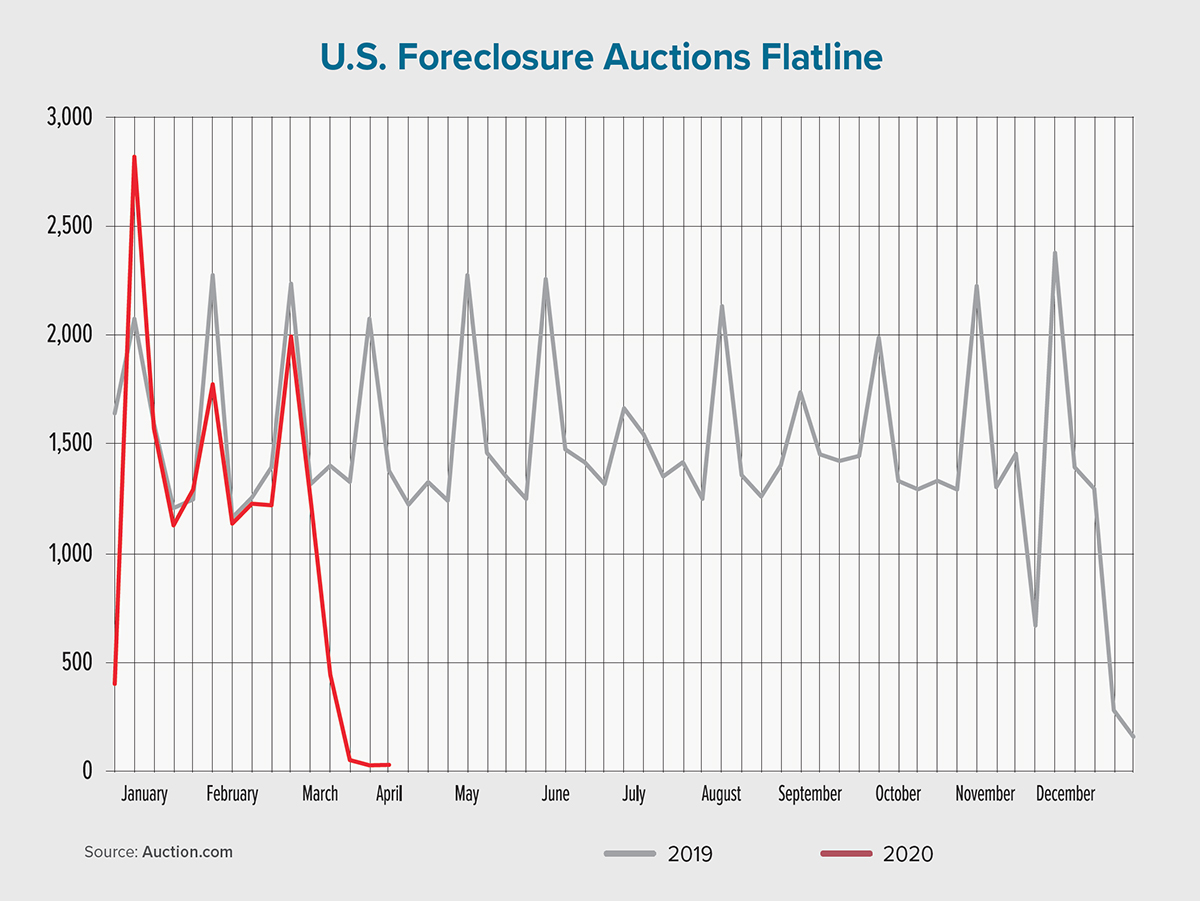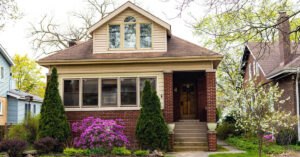A steady heartbeat of foreclosure auctions in early 2020 rapidly flatlined late this past March as the coronavirus crisis triggered a wave of nationwide foreclosure moratoriums.
From the start of this year through the week of March 8, an average of 1,500 properties per week were brought to foreclosure auction — meaning they either sold to third-party buyers or reverted to the foreclosing lender as real estate-owned properties — on the Auction.com platform. Fifty percent of all third-party foreclosure sales in 2019 were through Auction.com, according to an analysis of public-record data from Attom Data Solutions.
For the week of March 15, however, the number of properties brought to auction plummeted 64% week over week and were down 68% from the same week in 2019. That week’s massive decline followed some major milestones in the coronavirus crisis as the World Health Organization categorized the virus as a pandemic and President Donald Trump declared a national emergency two days later.
Completed foreclosure auctions continued to plummet and finally flatlined by early April following the passage of the CARES Act, which included a 60-day foreclosure moratorium on government-backed mortgages. Many states and banks instituted their own foreclosure moratoriums of varying length around that time.
The foreclosure moratorium on properties with federally backed mortgages was set to end on May 17 of this year, but it’s highly doubtful that foreclosure auctions will immediately return to business as usual even if the moratorium isn’t extended. That’s because there are many moving parts that impact the timeline for a return to normalcy.
The sharp pullback in foreclosure auctions also varied from state to state, a reflection of these moving parts. States with the earliest drop-off in foreclosure auctions included Indiana, Pennsylvania and Washington, all of which saw weekly declines of 60% or more during the week of March 8 — one week before the numbers dropped dramatically at a national level.
Join 210,000 mortgage professionals
Get the news, trends and industry updates in your inbox to become a better mortgage originator. Subscribe to emails below.
States that led the way in terms of foreclosure-auction pullback during the week of March 15 included Pennsylvania, Oklahoma, Wisconsin, Illinois, Kentucky, New York, Arkansas and Tennessee. Each of these states posted weekly declines of more than 70% at that time.
Historical precedent from the 2017 hurricanes centered on Texas and Florida sheds some light on what to expect in terms of a foreclosure- activity rebound. These storms indicate that the foreclosure heartbeat will show signs of life as early as five months after the peak of the coronavirus outbreak. It won’t completely recover its regular rhythm in most markets, however, for at least nine months.
In Houston, foreclosure auctions completed through Auction.com fell to less than 10 per month in the four months after Hurricane Harvey devastated the city in August 2017. Widespread foreclosure moratoriums were implemented during that time. Prior to the hurricane, completed foreclosures in Houston were averaging 130 per month in 2017.
During the first four months of 2018 — five to eight months after Harvey — the pace of completed foreclosures in Houston increased to an average of 54 per month, still less than half of the pre-hurricane rate. It wasn’t until May 2018, nine months after the hurricane made landfall, that the rate of auctioned properties moved above pre-hurricane levels.
To the extent that the coronavirus behaves similarly to a natural disaster like Hurricane Harvey — albeit on a much larger scale — expect a pattern similar to post-hurricane Houston to play out in local markets across the country. Foreclosure auctions will likely show signs of life five months after the worst of the crisis, surpass precrisis levels within nine months and return to a regular rhythm within 14 months.
Alternatively, if the outbreak creates something more like a traditional economic recession, a larger backlog of deferred foreclosures will build up as moratoriums are extended. Eventually, this would flood the housing market and result in a downward spiral that could last years rather than months.
Author
-

Daren Blomquist is vice president of market economics at Auction.com. In this role, Blomquist analyzes and forecasts complex macroeconomic and microeconomic data trends to provide value to both buyers and sellers using the platform. Blomquist has been cited by thousands of media outlets nationwide, including major news networks, The Wall Street Journal, The New York Times and USA Today. Prior to Auction.com, Blomquist worked at Attom Data Solutions.




